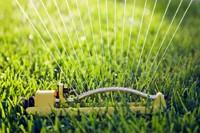Skip to main content
- Delay regular lawn watering during the first cool weeks of spring. This encourages deeper rooting and makes your lawn healthier for the rest of the summer.
- Don't sprinkle grass lightly, deep-soak it. Light watering causes the grass to develop shallow roots that are both less drought-resistant and more prone to winter kill.
- Water your lawn early in the morning. By 10 a.m., heat and evaporation go up, robbing the lawn of moisture. Watering at night is fine for dry climates, but in humid climates the relatively cool, moist conditions can create an ideal climate for lawn diseases to develop.
- If your grass grows on mostly clay soil, 1/4 to 1/2 inch of water per hour can be absorbed. If you have sandy soil, you'll need to water more often and for shorter periods of time. How you apply water is just as important as the amount. If your lawn thrives on 45 minutes of water every two to three days, it will not remain as healthy if you water 15 to 20 minutes every day.
- More water is dispensed faster with a larger diameter hose. Sprinklers that throw large drops in a flat pattern are much more effective than those with fine, high sprays, which can be blown about and evaporate quickly.
- Adjust your lawn mower to a higher setting. The longer grass blades will shade one another and the ground, helping to fight off heat and hold moisture longer.
- Mow the lawn at least once a week. Try to cut no more than 1/3 of the grass blade, removing about 1/2 to 3/4 of an inch. If you mow the grass shorter than this, excessive shock occurs that causes the grass to turn yellow despite your best watering efforts.
- Don't allow sprinklers to water your street, driveway or sidewalk. Position them so water lands on the lawn and shrubs... not on the paved areas.

